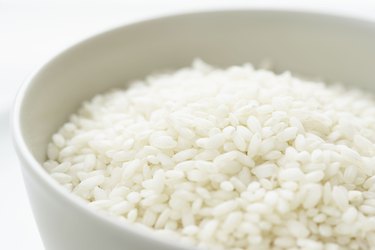
Rice has been cultivated for centuries and comes in a wide range of colors like black, red, brown and even purple in its unmilled form. It is grown throughout the world and is a major component of the common diet in Asia and elsewhere.
Raw Varieties
Video of the Day
Raw rice is the uncooked form. Commercial classification of raw rice is usually according to size — long-grain, short-grain or medium-grain, for example. The colors are primarily white or brown. Milled rice has had at least its husk and outer bran removed. White rice, also called "polished rice," has had its husk, bran and germ removed. Brown rice has had only its husk removed, has a nutty flavor and has more oil due to retention of the bran, the USA Rice Federation explains. Basmati and jasmine are aromatic varieties.
Video of the Day
Nutrition
Rice falls within the carbohydrate food group. Your body cannot digest raw rice, so nutritional value is given for cooked rice. One-half cup of rice provides approximately 100 calories. Though rice does not supply all the essential nutrients required for optimal nutrition, according to the Food and Agriculture Organization of the United Nations, it is a good source of thiamine, riboflavin, niacin and energy. Amino acids like aspartic acid and glutamic acid are present in rice; unmilled rice provides fiber. As of 2011, many manufacturers enrich rice with additional minerals and vitamins.
Cooked Varieties
When fully cooked, long-grain rice becomes fluffy and the grains stay separate. Medium-grain and short-grain rice tend to be moist when cooked, and are typically used in recipes requiring rice with a sticky consistency. Processed whole grains — like parboiled, frozen or pre-cooked — are also available; they vary in texture and taste.
Rice can be cooked in a variety of ways. It can be steamed, pressure-cooked, cooked in the microwave, baked or simply boiled.
Quantity
Rice increases in volume after cooking. In general, 1 cup of raw rice yields almost 3 cups of cooked rice. One-half cup of long-grain white rice is considered one serving.
Storage
After opening the package, store raw rice in airtight containers in a cool, dry place. Colored rice varieties like brown, red, black and purple should be stored in the refrigerator to prolong their shelf life. On the pantry shelf, brown rice may last up to 6 months.
Cooked rice can safely be stored in the refrigerator for 3 to 5 days. Cold rice should be held at a temperature below 41 degrees Fahrenheit.
- U.S. Department of Agriculture; Rice, White, Enriched, Long Grain; April 2009
- USA Rice Federation: Rice Types
- U.S. Department of Agriculture; United States Standards for Milled Rice; Nov. 27, 2009
- Food and Agriculture Organization of the United Nations; Rice and Human Nutrition
- USA Rice Federation: Storage
- USA Rice Federation: Consumer FAQs